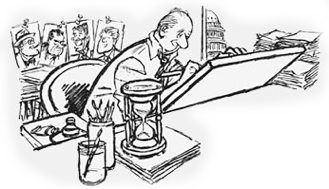School Bell: Education and Democracy in America
Herblock viewed teachers, students and their education as a top priority in the future of the nations. His legacy lives on, teaching and inspiring through his political cartoons, and in his grant, foundation and scholarship programs.
Reserve Exhibition
A Teacher's Guide
Herblock believed that a strong democracy is dependent upon an informed electorate. He believed that a strong education is what gives people the opportunity to reach their highest potential, to become respectable leaders and productive members of society. Herblock viewed teachers, students and their education as a top priority in the future of the nation. His legacy lives on, teaching and inspiring through his political cartoons, and in his grant, foundation and scholarship programs.
1. Herblock and You on Education, Cartoon Poster
Study Herblock 's cartoons based on education to analyze the issues and how he gets his point across, explaining that his work asks questions, creates ideas and dialogues. Have the students choose an issue in their own school directly and create a poster for display, addressing that issue. Explain it is the message that counts more than the artistic talent.
2. School History Assignment
Have students research the history of their school, noting what has changed through the years and in what ways the school can be improved. Using yearbooks from the library and articles from past conflicts at the school have them present a visual timeline of their discoveries to the class.
3. Design a School Assignment
Have the students do a collaborative drawing of what they think their school should look like, the facilities it should have and the types of teachers that they would like to have at the school. Encourage them to use symbols, caricature and exaggeration as well as words.
4. School in Other Countries
Ask the students to research what school is like in other countries by having them draw a slip of paper with a country written on it. Let them find out what a school day and year is like for children from these countries, how their problems and strengths compare to their own schools. Compare and contrast issues for differences and solutions. The assignment can be either visual, written or a combination of the two.
5. One Day in the Life of Our School, Project
Have the students chronicle a day in the life of their school. Suggest they tell the day's story from another point of view-someone from another country, planet, school or even an animal or object. Ask them how seeing through someone else's eyes gave them a new point of view.
6. Where Does the Money Go?
Have your class research where the money goes in this country instead of education. Suggest that they discover what the reasoning is by different politicians and where they stand on this issue. Have the students create images that show where the money goes and what the result is.
 Herb Block is among the world’s best known and most admired political cartoonists. Born on October 13, 1909, the native Chicagoan spent his 72-year career fighting against abuses of the powerful.
Herb Block is among the world’s best known and most admired political cartoonists. Born on October 13, 1909, the native Chicagoan spent his 72-year career fighting against abuses of the powerful.










